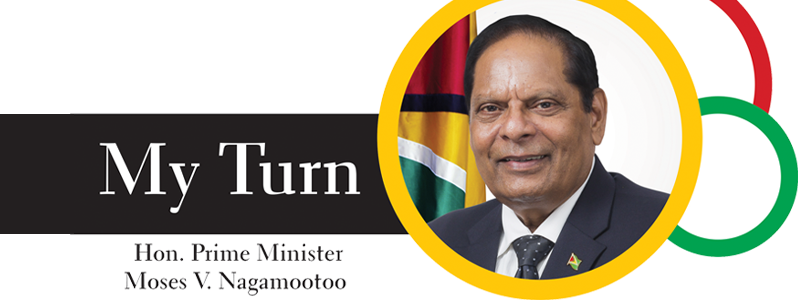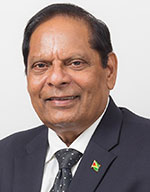WITH the discovery of some 5 billion barrels of oil, Guyana is literally sitting on top of the world. Before the recent 10th oil find, CEO John Hess stated that the Stabroek Block, off the Essequibo Coast “keeps getting bigger and better”. Earlier estimates placed oil revenues at US$700 million per year by the end of 2020, just from Exxon’s wells.
If a poll were to be taken on what is the biggest news item during 2018, it would be Guyana’s oil discoveries. It’s the singular most important event that drags us out from the past and propels us exponentially into the future.
It is within this context that I find treacherous the recent opportunistic and perhaps unlawful grab for power, that could destabilize our country and shake its image of confidence in the world. But it may turn out that that dastardly act might create only some ripples like a petard thrown into a pond, as against the waves that have been made about Guyana’s new democratic governance, and enviable potentials.
Side by side with the big news were the small stories of successes which alternated with emotional episodes of disappointment and hardships. On the top of the list was the closure of a few sugar estates and loss of jobs by some 4,000 among the estimated 17,000 work-force.
That, for me, was the most painful of all that I would experience during 2018. Though the affected workers were given severance benefits and some smaller numbers found alternative work, the pain would not go away until new businesses replace the broken sugar mills.
HEADLINE-GRABBING DRAMA
However, there were encouraging headline-grabbing dramas which included the holding of several national and international events, including the first ever Women’s T20 IPL cricket, the high-level International Civil Aviation Organisation (ICAO) conference, the run-off of Local Government Elections and the close-of-play controversy surrounding a vote of no confidence against the APNU+AFC Coalition Government.
For me, the real stories have been that our economy continues to grow and provides revenues to fund the fifth national Budgets in four years.
The acid test of social progress was the fact that by year-end, the Coalition Government could report an increase in the national minimum wage by over 50 per cent; Old Age pensions by 56 per cent, and [the] removal of thousands of workers from the tax band, with an increase of the income tax threshold.
Public service employees, including teachers and nurses, were ending the year with some smiles on their faces as salaries were readjusted upwards, and they took home a tax-free back-pay bonus. On average, it was bigger than the $50,000 and $25,000 Christmas bonuses in 2016 and 2015.
Against the harsher realities of the past, working people have just started to see benefits from the reduction in the dreaded Value Added Tax from 16 to 14 per cent, and from many more consumer items being made VAT free.
FIRST EVER TAX AMNESTY
While on the area of taxes, I wish to point out that during 2018, for the first time in the history of Guyana, a tax amnesty programme was implemented, together with e-services and paperless transactions. The Guyana Revenue Authority continued to de-centralise its operations with regional offices in far-off places such as Mabaruma, a recently-established township on the border with Venezuela.
The little things that go unnoticed would include the opening of the Bertram Collins College of the Public Service, where I gave a guest lecture on Politics and the Public Service. I have seen training centres opening their doors this year to children of sugar and bauxite workers, who have been the first recruits in the oil and gas sector.
Elsewhere, youths received vocational training and millions of dollars have been offered in micro-financing for startup projects. In the Rupununi this year, I took part in a graduation exercise under the Hinterland Employment Youth Service (HEYS), and the pride on the faces of young Amerindians as self-employed persons was unmistakably bright.
I have heard anti-government politicians prattle about there being no new jobs, but the Ministry of Business alone reported the creation of some 5,000 new jobs through a combination of efforts. These include disbursement from a $100 million Revolving Fund to help young entrepreneurs; the issuance of 2,700 loans and grants, the opening of Industrial sites at Belvedere and Lethem, and the creation of mining syndicates under which hundreds of mining blocks were handed out to small miners.
During the budget debate, as the opposition belly-ached about down-turn in business, our Minister of Indigenous People’s Affairs, Sydney Allicock, placed on his table, one after another, local products made in Guyana. He referred to the successes of the Turmeric factory in Hosororo, the successful harvesting of onions, and the progress in the processing of tomatoes, peanut butter and honey in hinterland communities. He spoke about the opening of nine new wells in the Rupununi, with residents getting clean drinking water for the first time.
Guyanese rice farmers did not complain as much this year as big markets in Mexico and Panama remain fully open; prices are improving bit by bit, and new varieties of paddy have been introduced. Massive drainage and irrigation works nationwide have been undertaken with multi-million-dollar pumps installed in the main agricultural regions. The rehabilitation of major farm-to-market roads has been an on-going exercise.
4G INTERNET
Without much fanfare, Guyana has witnessed the introduction of 4G internet with more schools provided free access. Over 100 government buildings were connected to the national network, and over 100 ICT hubs established across the country. Today, amongst the nation’s innovative programmes are the University Campus Area Network (CAN), and the Centre of Excellence in IT at the Turkeyen campus.
I can easily point to over 300 achievements under this government in a single year – one almost every day. Our people who benefit do not appear in the news, which remain heavily negative. But they know how much they are grateful for Internet and e-Services and regional radio broadcasts in the hinterland and remote communities. One foolish politician mocked that the interior people “can’t eat radio stations” little knowing how much these have been feeding our people with up-to-date information and entertainment.
They would say the same about the steamers that have been renovated and put back into service, the over 50 interior aerodromes and the critical stellings that have been fixed for riverine transport. But those would be a shadow of the kind of achievements that have been achieved, such as the 30 kilometre West Demerara road which I commissioned earlier this year when, shortly, the modern CJIA runway and terminal building and the four-lane East Coast Highway are completed.
NEW MODERN FEATURES
2018 has meant much to Guyana, which has witnessed new modern traffic features such as the Kitty Roundabout, pedestrian overpasses, expansion of the Sheriff Street-Mandela Avenue, the installation of road lamps countrywide, etc.
My heart beats with anxiety over prospects for a new four-lane Demerara Harbour Bridge; the bridging of the mighty Essequibo River and the completion of the Linden-Lethem highway.
More significant than oil wealth was the launch of a staunch defence of our country’s territorial integrity before the International Court of Justice (ICJ).
I have catalogued the achievements above not to boast about what our government has been doing, but to remind Guyanese that they should not allow themselves to be dragged into the past. We must go forward, although we may do so slowly.



.jpg)








